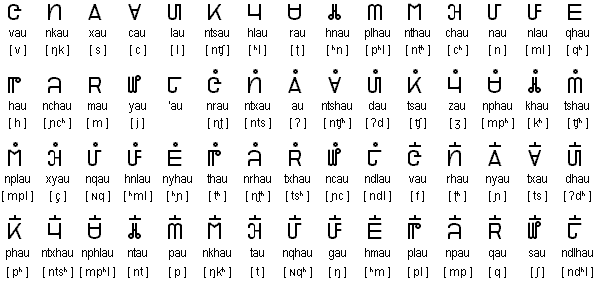The Pahawh Hmong alphabet was invented in 1959 by Shong
Lue Yang (![]() ), an illiterate Hmong farmer living in northern Laos
close to the border with Vietnam. Shong Lue Yang believed that
the alphabet was revealed to him by God, a belief shared by many
among the Hmong.
), an illiterate Hmong farmer living in northern Laos
close to the border with Vietnam. Shong Lue Yang believed that
the alphabet was revealed to him by God, a belief shared by many
among the Hmong.
Shong Lue Yang and his followers worked uncessingly to improve and disseminate his alphabet, and to bring about a revival of Hmong culture. In 1971 he was assassinated by government troops who were worried about his increasing influence.
Shong Lue Yang also created an alphabet for the Khmu language (a member of the Mon-Khmer family), but it never caught on and soon disappeared.
Hmong, an Austro-Tai language spoken by about 5.5 million people in China, Vietnam, Laos, Thailand and the USA.
In China Hmong is known as Miao and is written with Chinese characters or with an alphabet known as Pollard Miao. In Thailand, it is written with the Thai alphabet.
During the 1980s and 1990s several other alphabets were invented to write Hmong: Ntawv Paj Ntaub, based on Thai letters and Chinese characters, and Ai Ao Lo.
Today most Hmong write their language with the Romanized Popular Alphabet (RPA), a version of the Latin alphabet developed mainly by William Smalley, a missionary linguist, in the 1950s. In the RPA tones are indicated by final consonants.





Laix laix diangl dangt lol sob dab yangx ghax maix zit yef, niangb diot gid zenb nieef haib gid quaif lit gid nongd jus diel pinf denx. Nenx dol maix laib lix xent haib jox hvib vut, nenx dol nongt liek bed ut id xit deit dait.
Leb leb nis zib youl nangs, mex ad sheit nangd zend yanl nhangs njanl lib. Mix mex lix xinb gaot liangt send, leb leb lies nhangs ghob nab ghob geud nangd.
Cuat lenx cuat dol bongb deul ndax dex douf muax zif youx, nyaob shout zunb yinx tab ndas dos id, dax zis ib suk. Nil buab daf lol jaox muax lid xinf hlub hout tab liangx xinb shab nzhuk, yinf gaib keuk suk gud dix mol lol nit jinb shenx lol shib daf shib hlad.
All human beings are born free and equal in dignity and rights. They are endowed with reason
and conscience and should act towards one another in a spirit of brotherhood.
(Article 1 of the Universal Declaration of Human Rights)
Tower of Babel in White Hmong (Hmoob Dawb)
![]() Books about the Hmong language and people
Books about the Hmong language and people
Information about the Hmong language and people
http://en.wikipedia.org/wiki/Hmong_language
http://www.hmongnet.org
http://www.sytra.cn/hmong-translation-services.html
Online Hmong dictionary
http://www.HmongDictionary.com
Free Pahawh Hmong fonts
http://hmongscript.cwjmemhmong.info/download.html
http://www.pahauhhmong.org/downloadfont.html
http://www.hmongnet.org/hmongfonts/
Hmong Language Institute of Minnesotta
http://www.pahauhhmong.org
Hmong Nationality Archives
http://www.hmongarchives.org
Center for Hmong Studies, Concordia University, Saint Paul
http://www.csp.edu/hmongcenter/
Ahom, Balinese, Batak, Bengali, Brahmi, Buhid, Burmese, Chakma, Cham, Dehong Dai, Devanagari, Dhives Akuru, Ethiopic, Evēla Akuru, Gondi, Grantha, Gujarati, Gupta, Gurmukhi (Punjabi), Hanuno'o, Hmong, Javanese, Kannada, Kharosthi, Khmer, Lanna, Lao, Lepcha, Limbu, Lontara/Makasar, Malayalam, Manpuri, Modi, New Tai Lue, Oriya, Pallava, Phags-pa, Ranjana, Redjang, Shan, Sharda, Siddham, Sindhi, Sinhala, Sorang Sompeng, Sourashtra, Soyombo, Sundanese, Syloti Nagri, Tagalog, Tagbanwa, Takri, Tamil, Telugu, Thai, Tibetan, Tocharian, Varang Kshiti